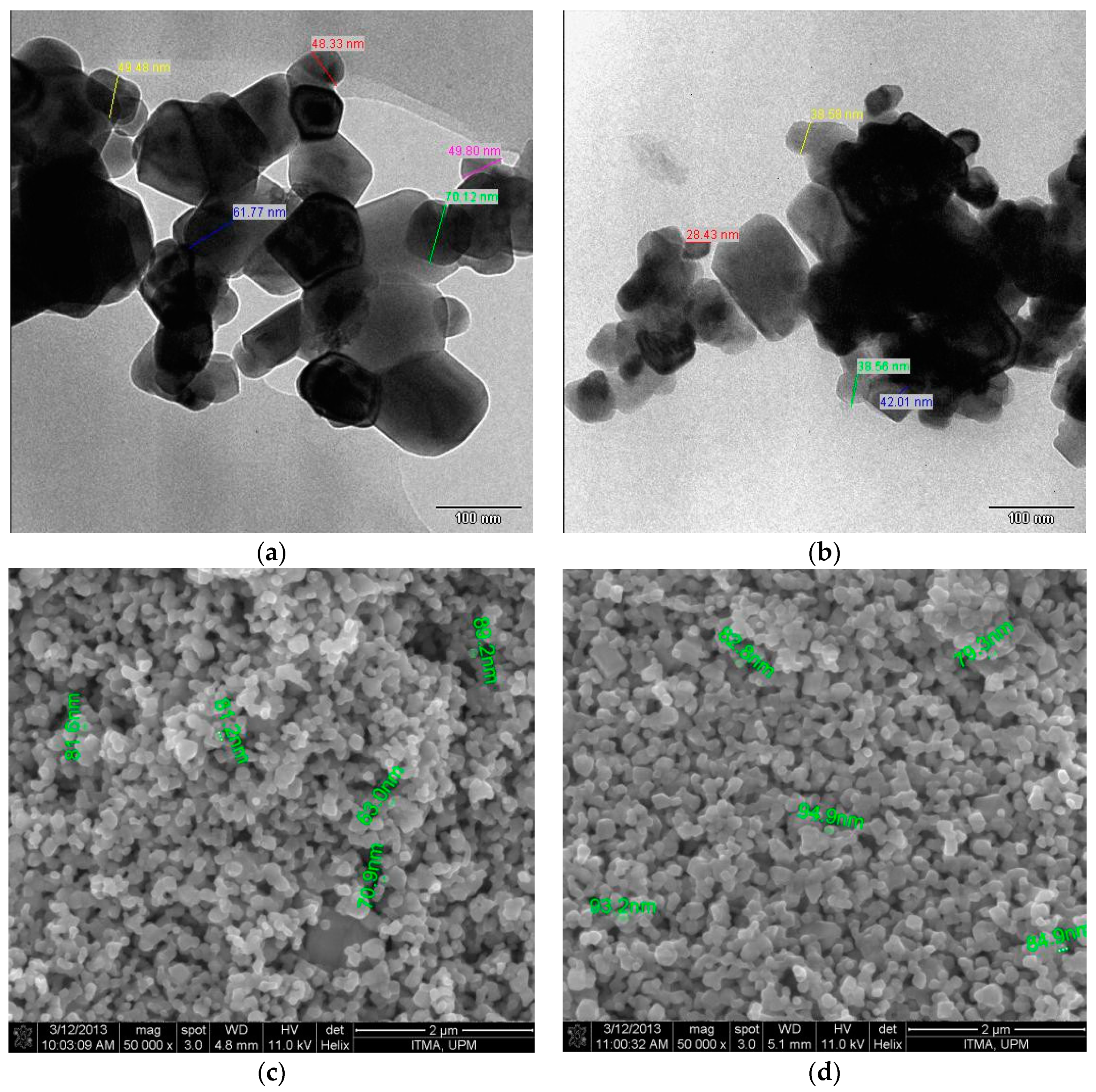Barium Strontium Titanate Humidity Sensor: Impact of Doping on the Structural and Electrical Properties †
Abstract
:1. Introduction
2. Materials and Methods
2.1. Materials Synthesis and Characterization
2.2. Device Fabrication and Characterization
3. Results and Discussion
3.1. Microstructural Properties
3.2. Humidity Sensitive Properties
Acknowledgments
Conflicts of Interest
References
- Tripathy, A.; Pramanik, S.; Cho, J.; Santhosh, J.; Osman, N.A.A. Role of Morphological Structure, Doping, and Coating of Different Materials in the Sensing Characteristics of Humidity Sensors. Sensors 2014, 14, 16343–16422. [Google Scholar] [CrossRef] [PubMed]
- Fenner, R.; Zdankiewicz, E. Micromachined Water Vapor Sensors: A Review of Sensing Technologies. IEEE Sens. J. 2001, 1, 309–317. [Google Scholar] [CrossRef]
- Enhessari, M.; Salehabadi, A. Perovskites-Based Nanomaterials for Chemical Sensors. In Progresses in Chemical Sensor; InTech: London, UK, 2016. [Google Scholar]
- Farahani, H.; Wagiran, R.; Urban, G. MgO-Doped (Zr,Sr)TiO3 Perovskite Humidity Sensors: Microstructural Effects on Water Permeation. In Proceedings; Multidisciplinary Digital Publishing Institute: Basel, Switzerland, 2017; Volume 1, p. 408. [Google Scholar]
- Wang, R.; Wang, D.; Zhang, Y.; Zheng, X. Humidity Sensing Properties of Bi0.5(Na0.85K0.15)0.5Ti0.97Zr0.03O3 Microspheres: Effect of A and B Sites Co-Substitution. Sens. Actuators B Chem. 2014, 190, 305–310. [Google Scholar] [CrossRef]
- Farahani, H. Synthesis and Fabrication of Nanocomposite Magnesia Doped Barium Strontium Titanate for Thick Film Humidity Sensor. Master’s Thesis, University Putra Malaysia (UPM), Selangor, Malaysia, 2013. [Google Scholar]
- Xiao, S.H.; Xu, H.J.; Hu, J.; Jiang, W.F.; Li, X.J. Structure and Humidity Sensing Properties of Barium Strontium Titanate/Silicon Nanoporous Pillar Array Composite Films. Thin Solid Films 2008, 517, 929–932. [Google Scholar] [CrossRef]


| Sample | Average Particle Size (nm) | Total Pore Volume (cm3/g) | Pore Radius (nm) | Surface Area (m2/g) | Average Grain Size (nm) |
|---|---|---|---|---|---|
| BST | 56 | 0.3 | 1.5 | 46.2 | 75 |
| 3 mol % MgO-BST | 36 | 0.3 | 95.3 | 8.1 | 90 |
Publisher’s Note: MDPI stays neutral with regard to jurisdictional claims in published maps and institutional affiliations. |
© 2018 by the authors. Licensee MDPI, Basel, Switzerland. This article is an open access article distributed under the terms and conditions of the Creative Commons Attribution (CC BY) license (https://creativecommons.org/licenses/by/4.0/).
Share and Cite
Farahani, H.; Wagiran, R.; Yurchenko, O.; Urban, G.A. Barium Strontium Titanate Humidity Sensor: Impact of Doping on the Structural and Electrical Properties. Proceedings 2018, 2, 1007. https://doi.org/10.3390/proceedings2131007
Farahani H, Wagiran R, Yurchenko O, Urban GA. Barium Strontium Titanate Humidity Sensor: Impact of Doping on the Structural and Electrical Properties. Proceedings. 2018; 2(13):1007. https://doi.org/10.3390/proceedings2131007
Chicago/Turabian StyleFarahani, Hamid, Rahman Wagiran, Olena Yurchenko, and Gerald A. Urban. 2018. "Barium Strontium Titanate Humidity Sensor: Impact of Doping on the Structural and Electrical Properties" Proceedings 2, no. 13: 1007. https://doi.org/10.3390/proceedings2131007
APA StyleFarahani, H., Wagiran, R., Yurchenko, O., & Urban, G. A. (2018). Barium Strontium Titanate Humidity Sensor: Impact of Doping on the Structural and Electrical Properties. Proceedings, 2(13), 1007. https://doi.org/10.3390/proceedings2131007






